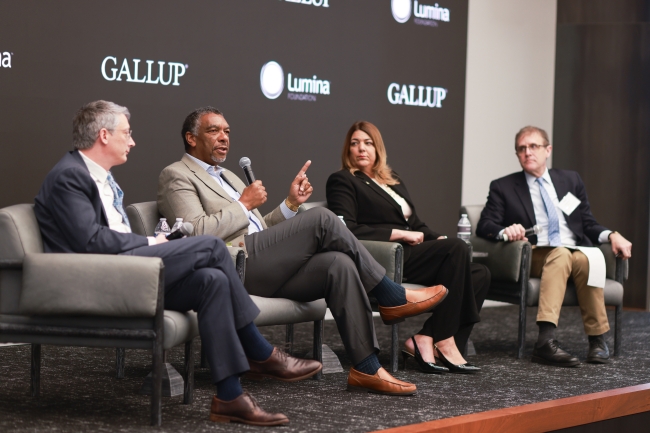You have /5 articles left.
Sign up for a free account or log in.

College leaders and policymakers including under secretary of education James Kvaal, far left, gathered in D.C. on Wednesday to unpack an eventful year for higher ed.
Inside Media Network
WASHINGTON, D.C.—One moderator introduced her panel at the Gallup and Lumina Foundation’s annual State of Higher Education event on Wednesday by reflecting on higher ed’s “tumultuous year.”
But the issues that defined the conversations throughout the day, and which seem poised to have a significant impact on the sector moving forward, were two ongoing crises: the pro-Palestinian student protests and the range of administrative responses they’ve provoked, and the bungled rollout of the new Free Application for Federal Student Aid (FASFA) form.
The former threatens to upend colleges’ approaches to longstanding values of campus speech and academic freedom; the latter has disrupted admissions and financial aid calendars, threatening to undermine years of progress on expanding college access.
And the ongoing enrollment crisis—the primary feature of last year’s Lumina event—hummed beneath it all.
A Disconnect on Value
Courtney Brown, Lumina’s vice president of strategic impact and planning, kicked off the event by calling attention to a data point in Lumina’s new survey with Gallup: Among adults not currently enrolled in postsecondary programs, nearly 90 percent said they considered at least one degree or certificate “extremely” or “very” valuable, and 59 percent said they’d thought about enrolling in the past two years.
There is some reason for optimism. Enrollments are beginning to recover; the National Student Clearinghouse reported in January that in fall 2023, undergraduate enrollments rose by 1.2 percent—the first increase since the COVID-19 pandemic.
But broad public confidence in the value of a degree is at an all-time low. Gallup’s own survey last summer showed that only 36 percent of Americans felt confident that a degree was a good investment, down nearly 20 points since 2015. And data reveals that lack of confidence is contributing to the languid enrollment growth since 2020’s nosedive.
Furthermore, enrollments are still lagging far behind pre-pandemic levels. Looming concerns about demographic shifts are forcing higher ed leaders to make difficult calculations.
“There are millions of seats empty at colleges across the country,” Brown told Inside Higher Ed after the event. “Colleges are going to need to either rethink their business models and start recruiting far more nontraditional students, or they need to start cutting some of those seats.”
Panelists at the event pointed exasperatedly to the disconnect between what the survey showed was widespread recognition that postsecondary credentials are the best path to upward socioeconomic mobility, and equally pervasive distrust in higher ed institutions. Combatting the latter and translating the former into actual enrollment has proven frustratingly difficult.
“I was very impressed by the results of the survey, because I came away thinking that Americans are not being hoodwinked. They understand that the path to a more prosperous life is a credential beyond secondary,” said John King, chancellor of the State University of New York system. “It is countering this other false narrative which says the majority of the country is not thinking that college is worth it. We have to get out in front of that.”
James Kvaal, the under secretary of education, pushed back on that characterization.
“As a believer in higher ed, I’d say the problem is not just with perception,” he said, noting that the average six-year college graduation rate hovers around 62 percent—and 50 percent for students of color. “It is my suspicion that the challenge we have is that a lot of young people know someone who went to college and took out a loan and didn’t complete … We do have to make sure that we’re delivering on the promise that we’re offering.”
The Gallup survey also highlighted struggles with retention and student success. Among the more than 6,000 currently enrolled students polled, 1 in 3 said they’d considered dropping out in the last six months. Of those, 64 percent listed mental health and stress as the reason—more than double the number that listed cost.
Campus Speech at a Crossroads
The panelists all acknowledged that the pro-Palestinian encampments are putting an unprecedented strain on colleges’ approach to protecting free speech, prompting a wave of police crackdowns, shape-shifting speech policies and threats to academic freedom.
“All of us are learning through this experience that we are still figuring out, what is free speech really?” said Donde Plowman, chancellor of the University of Tennessee at Knoxville. “How do you protect everyone’s speech and safety and keep normal activities going in a time like this? We set up processes for doing that, and in the midst of a crunch you find out how good or weak those processes are.”
Her campus didn’t have much in the way of student protests or encampments this spring, which have challenged speech policies at other institutions. But when a large pro-Palestinian demonstration was organized at Knoxville last week, seven students were arrested for remaining assembled on the lawn of the law school half an hour after campus policy allowed them to be.
After the panel, Plowman told Inside Higher Ed that deciding to arrest students was a matter of respecting university policies. She does not believe that administrators calling in police to break up protests are undermining higher ed’s larger free speech commitments, though she said the current protest movement is challenging assumptions about how to respectfully engage in dialogue.
“We actually protect free speech when we enforce the rules,” she said.
What protecting free speech actually means to universities emerging from this moment seemed less clear.
“We are at a moment now where we’re going to have to either defend or walk away from some basic notions of free expression that have long defined us,” David Wilson, the president of Morgan State University, told the panel audience.
FAFSA Fugue
The bungled rollout of the new FAFSA has loomed large over higher ed this year, heightening political divisions in Congress and wreaking havoc on colleges’ admissions and financial aid timelines.
It also feeds into enrollment concerns. As of mid-April, FAFSA completions were still 24 percent behind last year’s, a lag that could mean hundreds of thousands fewer matriculating students in the fall—largely low-income students of color.
On Monday, the department announced a new Student Support Strategy to close that gap. When asked about the initiative at the panel, Kvaal, who has handled most of the FAFSA fixes in recent months, expressed optimism and urgency—though he acknowledged that college commitment deadlines, even extended ones, were coming up fast.
“We found new resources to invest in FAFSA night activities, we’re working with local and state officials, we’re sending emails and texts to students and counselors … we’re going to leave no stone unturned here,” Kvaal said. “We do have a lot of momentum, and we are making progress week-by-week. But there’s a lot of work left to do.”
That work is affecting the ability of some colleges to plan for the fall. Plowman told Inside Higher Ed that UT Knoxville has had far fewer students commit at this point in the admissions season than usual, even after extending its deadline to May 15.
“We have to get this class confirmed soon, and we still have no idea who’s coming,” she said. “Students are shopping around, and they can’t make a choice without their aid offers.”





